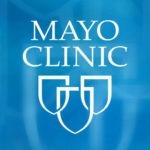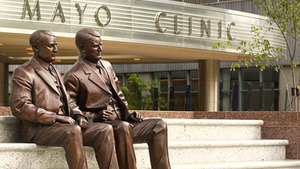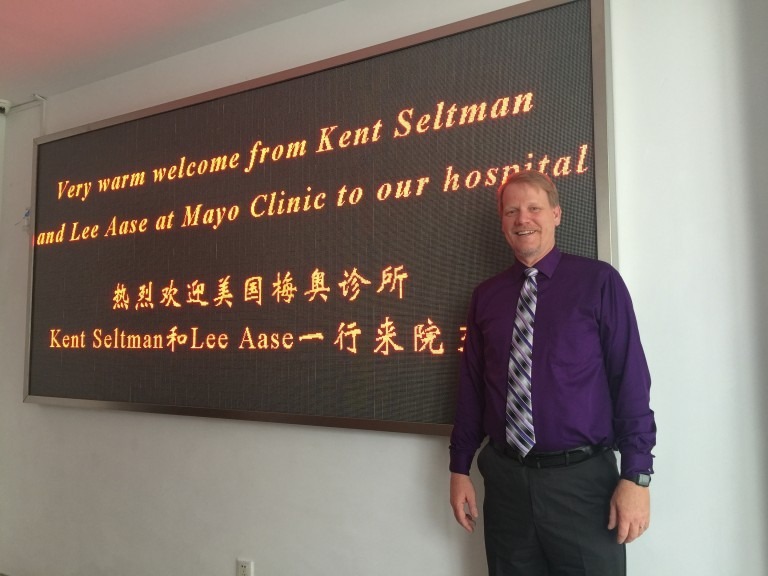Mayo Clinic’s Commitment to Sharing Best Practices Extends to Social Media
// By Jane Weber Brubaker //
 The time change between China and the U.S. made it relatively easy to connect with Lee Aase, Director of Mayo Clinic Social Media Network; it was Wednesday evening on the East Coast, and Thursday morning in Beijing—12 hours apart. Aase was on a two-week trip to China in June, scheduled to speak at nine hospitals, with Kent Seltman, co-author of Management Lessons from Mayo Clinic: Inside One of the World’s Most Admired Service Organizations. Seltman is former Marketing Division Chair at Mayo Clinic.
The time change between China and the U.S. made it relatively easy to connect with Lee Aase, Director of Mayo Clinic Social Media Network; it was Wednesday evening on the East Coast, and Thursday morning in Beijing—12 hours apart. Aase was on a two-week trip to China in June, scheduled to speak at nine hospitals, with Kent Seltman, co-author of Management Lessons from Mayo Clinic: Inside One of the World’s Most Admired Service Organizations. Seltman is former Marketing Division Chair at Mayo Clinic.
“A significant part of the story I am telling in China about our experience is that social networking really isn’t anything new,” says Aase. “Dr. Will and Dr. Charlie Mayo were our first social networkers. They really believed that to do the best care for patients, they needed to learn from others, and they felt an obligation to share what they were learning in their practice.”
The theme of learning and sharing has been carried over to Mayo Clinic Social Media Network (MCSMN), a lively community of clinicians and communicators dedicated to sharing best practices in social media. “The digital tools are just taking the analog way that we’ve always done things and made it more efficient, and much faster,” says Aase.
Mayo Clinic Provides “Air Cover” for Other Organizations

Statue of Drs. William and Charlie Mayo
MCSMN began in 2010 as an internal effort to increase the application of social media throughout the organization. “It’s first a resource for our employees, enabling them to learn best practices,” says Aase. But it has since evolved into a global community extending beyond Mayo Clinic’s walls to other hospitals, healthcare communications professionals, medical providers, patients, and caregivers.
“Our goal was to say, okay, like Dr. Will and Dr. Charlie who were sharing with colleagues around the world, let’s do the same thing in social, because there were so many hospitals that were bumping up against concerns like HIPAA,” says Aase. “So the fact that Mayo Clinic was doing this provided some air cover for our colleagues outside the organization.”
Advanced Training for Social Media Advocates
Mayo Clinic has a very large residency program, and MCSMN pivoted off the concept, naming its one-day training program Social Media Residency. “The primary purpose was to share case studies and examples of productive and effective use of these tools, not just in promotion, but in patient education, recruitment in clinical trials, and employee communications, to be able to create some familiarity and comfort with the tools,” he says. Social Media Residency is offered at the main campus in Rochester, Minnesota, as well as Mayo Clinic Scottsdale, Arizona, and Mayo Clinic Jacksonville, Florida.
800 Clinicians and Communicators and Counting
The makeup of participants has been about one-third clinicians, and two-thirds marketing and communications professionals. Aase estimates that close to 800 people have taken the residency course. The daylong schedule begins and ends with a discussion of strategy, and in between, participants receive training on best practices using major social media platforms, including Twitter, Facebook, Pinterest, Instagram, and LinkedIn as well as a session on video and live video streaming on Periscope. Mayo Clinic’s YouTube channel features more than 4,500 videos, the earliest posted eight years ago.
The cohorts for each session have ranged in size from 12 to 100. In larger groups, members of the MCSMN External Advisory Board act as “Chief Residents,” leading small-group discussions during the program. Members of the advisory board are physicians, medical students and medical school professors, communications consultants, attorneys, marketing directors, and other industry thought leaders.
Online Certificate Available in Social Media Basics
Just as medical residency is advanced training, Social Media Residency is not for rank beginners. To fill the need for more basic training, MCSMN worked with HootSuite, creators of a widely used social media management platform, and developed an online certificate program, Social Media Basics. The four-hour online course is a prerequisite for Social Media Residency, and gives participants the necessary foundation to take full advantage of the higher-level course. “When people come [to Social Media Residency], they would at least have a basic understanding of the tools so that we could focus more on strategy and on developing a plan for application,” says Aase.
Fellows Program Recognizes Leaders in Applying Principles
MCSMN created the Social Media Fellows Program to take the training to the next step—applying the principles to real-world problems. There are four levels:
- Bronze Fellow—create a strategic plan for social media (example)
- Silver Fellow—execute the plan
- Gold Fellow—share the results with a broader audience (example)
- Platinum Fellow—the highest level of community involvement, engagement, and contribution. It is conferred by nomination. MCSMN awarded Platinum Fellow designation to five individuals in 2013, and four in 2014.
At Mayo Clinic, the patient is the primary focus of social media, according to Aase. “That focus is part of both our academic medical health center mission, as well as our historical DNA.” As all healthcare organizations strive to become more “patient-centered,” learning how to connect effectively with patients through social media is an increasingly critical need.
Regarding the trajectory of social media, Aase notes, “It’s clearly going to be an expectation that this is the way people are communicating. Never before have there been these opportunities to communicate across time and space, and overcome these barriers. It’s something we take advantage of, and others can do that, too.”
Jane Weber Brubaker is the Editor of eHealthcare Strategy & Trends. Contact her at jane@ehealthcarestrategy.com.


